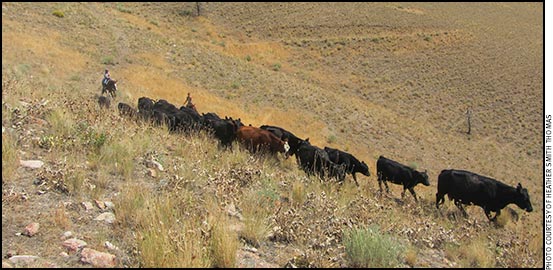
Move ’em Out … Slowly
Cattlewoman offers tips for working cattle in the summer heat.
On a hot summer day, cattle overheat quickly if they exert too much energy. Moving cattle is safer for the animals if you can do it during the coolest part of the day, starting early in the morning.
It’s also important to let cattle go their own speed. Don’t try to hurry or chase them. Low-stress handling is better for the cattle, especially if it will be a hot day and/or a long trail drive.
Watch for signs of heat stress, and give cattle a rest if they start to overheat. The first signs will be fast respiration/panting, breathing with mouth open and excessive salivation. They will be breathing fast because they are exerting energy, but when overheated panting becomes very noticeable, it’s time to take a rest. If you push them, you’ll see some of them start to stumble and stagger.
If you let cattle pick their own pace and move them in a cooler part of the day, they can go much farther before or without suffering heat stress. If they only have a short distance to go, you can move cattle in the evening before dark; however, usually early morning is best. If it’s a hot day, the cattle will accumulate body heat and will be very hot by evening. It’s best to start when they are cooler.
All too often, producers forget to go “cow speed” and push them too fast. Never try to push the herd any faster than it wants to travel. Four-wheelers often push cattle too fast. Even on horseback, you may need to slow down, since horses walk faster than cattle. Horses walk at about 4-5 miles per hour (mph), but cows travel comfortably at about 2-3 mph. Cows with young calves may need to move even more slowly. Some horses readily pace themselves behind a herd of cattle and walk more slowly, but many won’t. It may help to ride a zigzag pattern behind the cows.
As one old cowboy observed a long time ago, “The fastest way to move cattle is slowly.” Let them go their own speed, quietly and in pairs. With this method, everything is more likely to go smoothly and efficiently, and it’s less stress for everyone. It avoids cows or calves trying to quit the herd to go back to where they last saw mama (or baby). When you get to your destination, the cattle will be able to settle down to graze — mothered up, content and comfortable.
Don’t crowd cattle. Stay a little bit behind them, so they are not stressed. It is best to give them room and time so they string out single file (the way cattle naturally travel, following a leader). They will be relaxed if allowed to go their own speed.
Many riders make the mistake of bunching them up in a mob. Pairs get jostled and separated and bawl for one another — especially if you get cattle upset by trying to move them too fast or worry them with dogs. Pretty soon cows don’t know where their calves are, and they will try to run back to find baby, even if baby is right there in the mob — and this adds more stress. If cows or calves expend energy worrying and trying to find mama or baby, they overheat faster.
When moving cows with calves, pay attention to their pace and level of stress. If the speed is too fast or the distance is too far for young calves to travel without wearing out or overheating, stop the herd a few times. On a hot day, if calves start drooling or breathing with their mouths open, they are tired and overheated. Let the herd rest and get mothered up before you continue. You don’t want to kill a calf with heat stress.
Traveling slowly, with rest stops if necessary, is the best way to move cattle.

Editor’s Note: Heather Smith Thomas is a freelance writer and cattlewoman from Salmon, Idaho.






